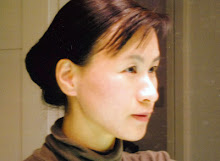How to Grind an Ink-Stick (or Japanese “Sumi”)

For the best result, I highly recommend you to use an ink-stone for ink-stick grinding. Both ink-stick and stone are available at “SHEPHERDS (formerly FALKINER fine papers)” at Russell Square
Step 1:
Pour a little amount of distilled water onto the ink-stone.
Step 2:
Dip the tip of the ink-stick in the pool on the ink-stone, and grind the ink-stick around the centre of the ink-stone. Please do not leave the stick in the ink pool because it causes expansion, which results in cracks. Repeat this dip & grind procedure to attain the sufficient concentration. This process usually takes 5 ~10 minutes. Transfer the ground liquid to a larger dish (a white coloured dish is best to tell the ink concentration).
Step 3:
Add distilled water little by little to dilute the ground ink to your chosen sumi colour. (The contained gelatine must be bonded enough at Step 2, and you are safe to water it down at this stage.)
===Tips for the Advanced Users===================
• To bring out the best result, water temperature around 24C is recommended.
• Please always lay the ink-stick in level, and dry it after every use. This will prevent ink-stick’s deterioration such as cracking or mildew.
• Often heard that the grind force shouldn’t be too strong. My teacher explained the proper strength to me with a figurative speaking “13 years old girl is the best ink grinder” which is still confusing. The Sumi ground according to the above instruction should be deep in colour and mild in sheen.
• As long as I tried, 2x5cm sized stock can paint at least 9 square meters (in very deep black). An Ink-stone is bit expensive but it last for many years (even 100 years).
Ink Problems?
• If you are ever struggling with an ink-running problem or an ink-removal problem, adding some drops of vinegar may solve the problem. Not for all kind of inks, but it works sometimes.

For the best result, I highly recommend you to use an ink-stone for ink-stick grinding. Both ink-stick and stone are available at “SHEPHERDS (formerly FALKINER fine papers)” at Russell Square
Step 1:
Pour a little amount of distilled water onto the ink-stone.
Step 2:
Dip the tip of the ink-stick in the pool on the ink-stone, and grind the ink-stick around the centre of the ink-stone. Please do not leave the stick in the ink pool because it causes expansion, which results in cracks. Repeat this dip & grind procedure to attain the sufficient concentration. This process usually takes 5 ~10 minutes. Transfer the ground liquid to a larger dish (a white coloured dish is best to tell the ink concentration).
Step 3:
Add distilled water little by little to dilute the ground ink to your chosen sumi colour. (The contained gelatine must be bonded enough at Step 2, and you are safe to water it down at this stage.)
===Tips for the Advanced Users===================
• To bring out the best result, water temperature around 24C is recommended.
• Please always lay the ink-stick in level, and dry it after every use. This will prevent ink-stick’s deterioration such as cracking or mildew.
• Often heard that the grind force shouldn’t be too strong. My teacher explained the proper strength to me with a figurative speaking “13 years old girl is the best ink grinder” which is still confusing. The Sumi ground according to the above instruction should be deep in colour and mild in sheen.
• As long as I tried, 2x5cm sized stock can paint at least 9 square meters (in very deep black). An Ink-stone is bit expensive but it last for many years (even 100 years).
Ink Problems?
• If you are ever struggling with an ink-running problem or an ink-removal problem, adding some drops of vinegar may solve the problem. Not for all kind of inks, but it works sometimes.
